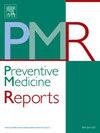青少年亚裔美国人和太平洋岛民的大麻使用:种族亚群和性别差异分析
IF 2.4
3区 医学
Q2 PUBLIC, ENVIRONMENTAL & OCCUPATIONAL HEALTH
引用次数: 0
摘要
目的评估青少年亚裔美国人和太平洋岛民(AAPI)亚群大麻使用的异质性。方法参与2019-2020年加州学生烟草调查的saapi高中生(n = 31,071)按种族/民族分类,并检查了过去和现在(过去30天)的大麻使用情况。描述性统计被用来描述大麻的使用和亚组的危害认知。使用多元逻辑回归将大麻使用亚组与其他人口统计数据作为协变量进行比较。结果目前各民族大麻使用率分别为:华人4.2%、韩国人4.9%、印度人5.2%、越南人6.0%、苗族人6.4%、巴基斯坦人6.6%、日本人9.4%、菲律宾人9.6%、柬埔寨人17.9%、其他单一民族亚洲人10.5%、太平洋岛民22.3%。单种族、多种族和多种族的亚太裔药物使用率分别为7.3%、9.1%和18.5%,多种族的亚太裔药物使用率高于单种族和多种族的亚太裔药物使用率(p’s <;0.001)。在整个亚太裔中,11.3%的人目前使用大麻。目前,女性的使用率高于男性,分别为10.8%和9.6% (p = 0.011)。曾经和现在使用大麻与认为每天和偶尔使用大麻有害的看法呈负相关(p <;0.001)。与中国学生相比,除韩国人和巴基斯坦人外,所有亚组都更有可能使用大麻(所有p's <;0.05),而菲律宾人、日本人、柬埔寨人和太平洋岛民的可能性是前者的两倍多(p's <;0.001)。结论亚太裔青少年不同族裔间大麻使用率存在较大的异质性。几个亚太裔亚组吸食大麻的比例较高。在亚太裔青少年中,基于性别的趋势已经交叉。本文章由计算机程序翻译,如有差异,请以英文原文为准。
Marijuana use among adolescent Asian Americans and Pacific islanders: Analysis of ethnic subgroup and gender differences
Objective
To assess heterogeneity in marijuana use among adolescent Asian American and Pacific Islander (AAPI) subgroups.
Methods
AAPI high school students (n = 31,071) participating in the 2019–2020 California Student Tobacco Survey were categorized by race/ethnicity and examined for ever and current (past-30-day) marijuana use. Descriptive statistics were used to describe marijuana use and harm perceptions by subgroups. Multiple logistic regression was used to compare subgroups on marijuana use with other demographics as covariates.
Results
Current marijuana use rates by ethnic subgroups were: Chinese 4.2 %, Koreans 4.9 %, Indians 5.2 %, Vietnamese 6.0 %, Hmong 6.4 %, Pakistanis 6.6 %, Japanese 9.4 %, Filipinos 9.6 %, Cambodians 17.9 %, other monoethnic Asians 10.5 %, and Pacific Islanders 22.3 %. Current use rates for monoethnic, multiethnic, and multiracial AAPIs were 7.3 %, 9.1 %, and 18.5 %, respectively, with multiracial AAPIs using at a higher rate than monoethnic and multiethnic AAPIs (both p's < 0.001). Among AAPIs overall, 11.3 % currently used marijuana. Females currently used at a higher rate than males, 10.8 % vs. 9.6 % (p = .011). Ever and current marijuana use were negatively correlated with perceptions that everyday and occasional use is harmful (all p's < 0.001). Compared to Chinese students, all subgroups except Koreans and Pakistanis were more likely to use marijuana (all p's < 0.05), with Filipinos, Japanese, Cambodians, and Pacific Islanders more than twice as likely (all p's < 0.001).
Conclusions
There was substantial heterogeneity in marijuana use rates among ethnic subgroups of AAPI adolescents. Several AAPI subgroups used marijuana at elevated rates. Gender-based trendlines among AAPI adolescents have crossed.
求助全文
通过发布文献求助,成功后即可免费获取论文全文。
去求助
来源期刊

Preventive Medicine Reports
Medicine-Public Health, Environmental and Occupational Health
CiteScore
3.90
自引率
0.00%
发文量
353
 求助内容:
求助内容: 应助结果提醒方式:
应助结果提醒方式:


